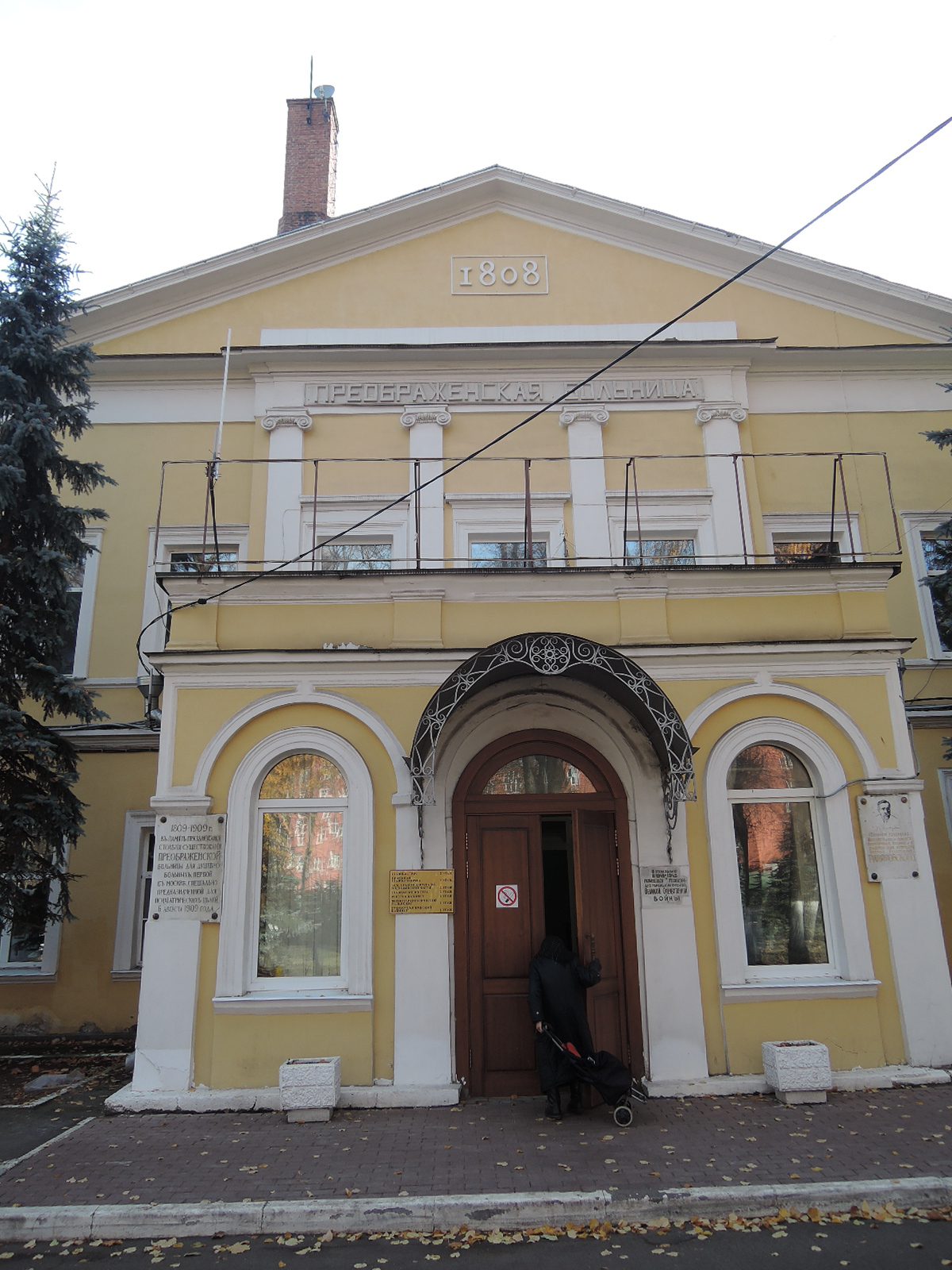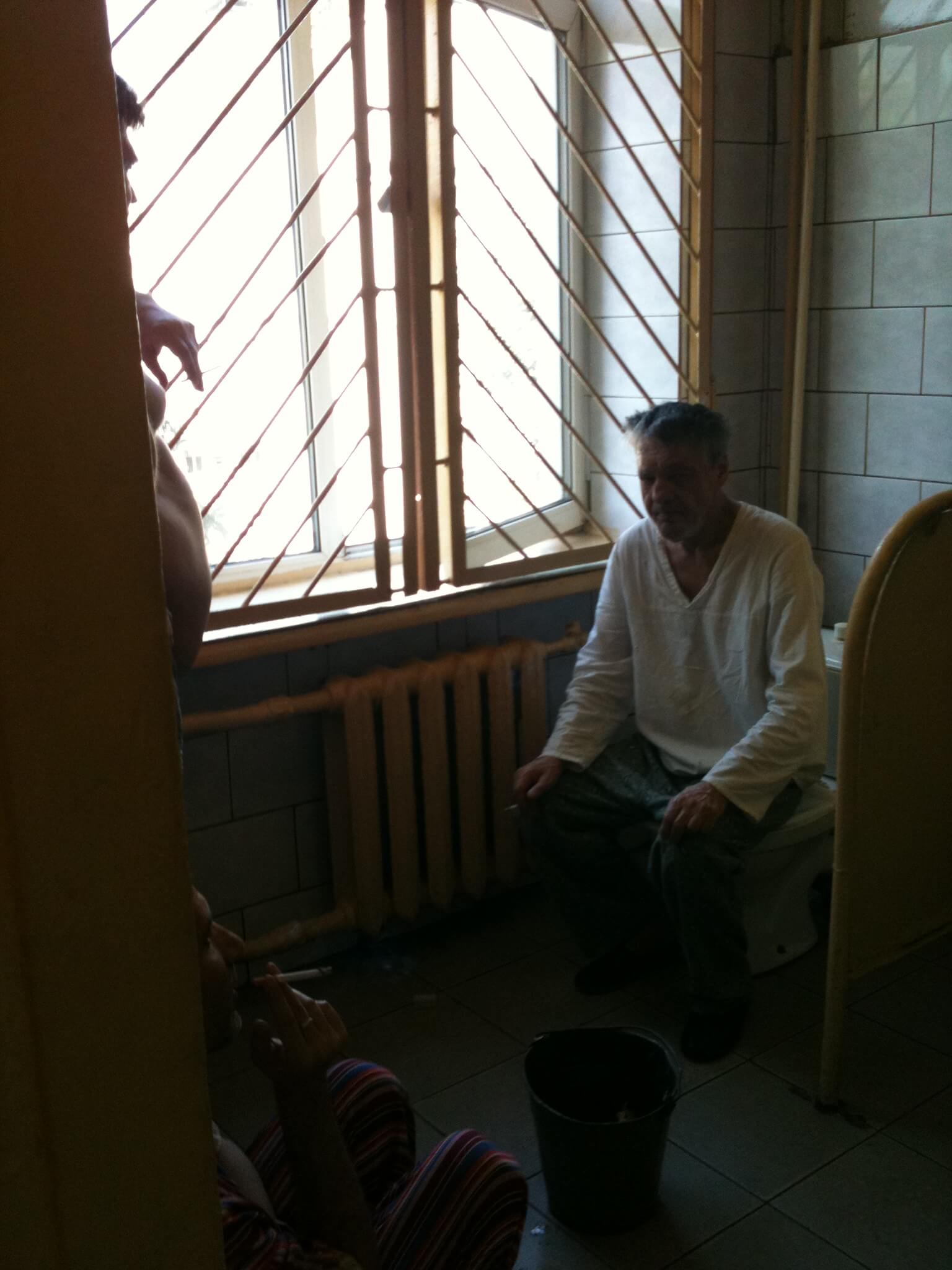Sergei Jargin
Moscow, Russia
 |
| Fig. 1. Gilyarovsky psychiatric hospital in Moscow, founded 1808. |
The Gilyarovsky and Gannushkin psychiatric hospitals can be discussed together because the latter was founded in 1913 as a branch of the former, becoming a separate institution only in 1931. Both hospitals are located not far from each other, near the Sokolniki Park and Yauza River.1 The Gilyarovsky hospital, founded 1808 (Fig. 1), was the first psychiatric hospital in Moscow. It was initially called a madhouse and had only eighty beds. In 1838 it was renamed the Transfiguration (Preobrazhenskaya) psychiatric hospital. In 1911 it had 510 beds, but the number of patients hospitalized there was often higher. During the second year of my medical education (1978/79), I worked part-time as an attendant at the Gannushkin hospital. The patients cleaned the premises themselves; and in return the attendants would usually bring them a package of black tea. Patients drank very strong black tea, named chifir, rich in caffeine, as a minor drug or stimulant, of which a 50 g package was cooked in a 1.5–2 l teapot or can. This habit has been widespread in psychiatric and penal institutions. There were no electric sockets in the ward rooms, so the patients cooked chifir in the lavatory, where they had invented a convoluted system using a ventilator cable beneath the ceiling and a cooker in a can. Some nurses allowed patients to cook chifir in the kitchen as long as they were accompanied by an attendant. After that the patients would spend the night in the lavatory smoking cigarettes and talking. Smoking was permitted only in the toilets. Male attendants tended to be bossy. Some attendants would beat the patients. I saw that only once, because we were usually alone on duty. Once I hit a patient myself: he was aggressive and I was on duty alone. It certainly was professional misconduct, which I sincerely regret today. Personnel must have instructions on how to act in certain circumstances. We had no instructions at all. The most remarkable change during the last decades has been the major repairs (so-called Euroremont—a Russian neologism meaning repairs supposedly according to European standards). Major repairs are performed in many old edifices in Russia today, including those recognized as objects of cultural heritage,2,3 but sometimes done within a framework of corruptive interactions of hospital administrators with construction firms. In many hospitals the wards, corridors, and lavatories remain crowded. Overcrowding of the toilets is increased because patients use them to smoke there. There are usually no cubicles, and lavatory pans and urinals are in the same room. Some patients sit on the pans and on the floor smoking while others come to use the toilets. (Fig. 2)

Smoking by patients in psychiatric hospitals remains a major problem.11,12 Objections to setting up smoking rooms are well-founded, based on the desire to have patients give up smoking during their hospital stay, but leaving inveterate smokers with the only option of smoking in toilets, with often no cubicles and reducing others to using a lavatory pan in sight of the smoking public. One might accordingly agree with those researchers who favor having smoking rooms in psychiatric hospitals to preserve the patients’ self-esteem.12 Likewise, instead of undertaking costly major repairs it would seem more reasonable to build new modern units large enough to move there some of the patients from the old hospitals, and at the same time thus preserve the architecture of such historic buildings as Gannushkin and Gilyarovsky psychiatric hospitals.The internal layout of psychiatric hospitals has special requirements, such as to enable surveillance and stop patients from leaving the hospital. These requirements are now less important because the treatment of mental diseases has improved, as have individual rehabilitation schemes. But there is a need to provide more separate rooms for patient privacy, and also more opportunities for social life to enable them to overcome isolation and socialize more actively, even to allow some opportunities for contact with the opposite sex.4,5 The emphasis of psychiatric therapy in Russia has focused on the medical treatment, sometimes with insufficient consideration of the need for social and occupational rehabilitation.6 In the past, over-institutionalization of patients with mental disorders has been the usual practice,7 although after the political changes in 1989 the number of general psychiatric hospital beds has been substantially reduced and that of forensic psychiatric beds increased.8 Even though hygiene and other conditions have recently improved, conditions in long-stay psychiatric hospitals remain rather primitive: certainly not in conformity with the recommendations of the Council of Europe,9 with overcrowding, no privacy, and insufficiently clean toilets in the corridors, all in need of improvement.10
References
- Tyklina IG, Vol’f MSh. History of the P. B. Gannushkin Moscow city clinical psychiatric hospital. Med Sestra. 1984;(7):45-46. (Russian)
- Jargin S. Environmental aspects of Moscow reconstruction: dust, allergy and asbestos. Domus News of 5 May 2010 http://www.domusweb.it/en/news/2010/05/05/environmental-aspects-of-moscow-reconstruction-dust-allergy-and-asbestos.html
- Jargin S. Clinics of Moscow University. Domus News of 17 February 2010 http://www.domusweb.it/en/news/2010/02/17/clinics-of-moscow-university.html
- Gebhardt RP, Steinert T. Internal structure of inpatient psychiatric hospital care 22 years after the psychiatry inquest. Nervenarzt. 1998;69(9): 791-798. (German)
- Scala A. Buildings for mental patients: from the architecture of isolation to the architecture of integration. Zh Nevropatol Psikhiatr Im S S Korsakova. 1990;90(11): 90-92. (Russian)
- Jenkins R, McDaid D, Nikiforov A, Potasheva A, Watkins J, Lancashire S, Samyshkin Y, Huxley P, Atun R. Mental health care reforms in Europe: Rehabilitation and social inclusion of people with mental illness in Russia. Psychiatr Serv. 2010;61(3): 222-224.
- Jenkins R, Klein J, Parker C. Mental health in post-communist countries. BMJ. 2005;331(7510): 173-174.
- Mundt AP, Frančišković T, Gurovich I, Heinz A, Ignatyev Y, Ismayilov F, Kalapos MP, Krasnov V, Mihai A, Mir J, Padruchny D, Potočan M, Raboch J, Taube M, Welbel M, Priebe S. Changes in the provision of institutionalized mental health care in post-communist countries. PLoS One. 2012;7(6):e38490.
- Kingdon D, Jones R, Lönnqvist J. Protecting the human rights of people with mental disorder: new recommendations emerging from the Council of Europe. Br J Psychiatry. 2004;185: 277-279.
- Jargin SV. Some aspects of psychiatry in Russia. Int J Cult Ment Health 2011;4(2): 116-120
- Hall SM, Prochaska JJ. Treatment of smokers with co-occurring disorders: emphasis on integration in mental health and addiction treatment settings. Annu Rev Clin Psychol. 2009;5: 409-431.
- Skorpen A, Anderssen N, Oeye C, Bjelland AK. The smoking-room as psychiatric patients’ sanctuary: a place for resistance. J Psychiatr Ment Health Nurs. 2008;15(9): 728-736.
graduated from the I.M. Sechenov Medical Academy in Moscow in 1983. He received postgraduate training in pathology at the same institution until 1986. Thereafter, he was a pathologist and lecturer at the I.M. Sechenov Medical Academy (recently renamed university). Since 1995, he has been a lecturer at the Peoples’ Friendship University of Russia in Moscow. His scientific interests include social, medical, and pathological aspects of alcohol consumption, alcoholism and alcohol-related dementia, child and elder abuse and neglect. He is author of the book: Alcohol consumption in Russia 1970-2014 (LAP LAMBERT Academic Publishing, 2014).
Highlighted in Frontispiece Fall 2015 – Volume 7, Issue 4
Fall 2015 | Sections | Hospitals of Note

Leave a Reply